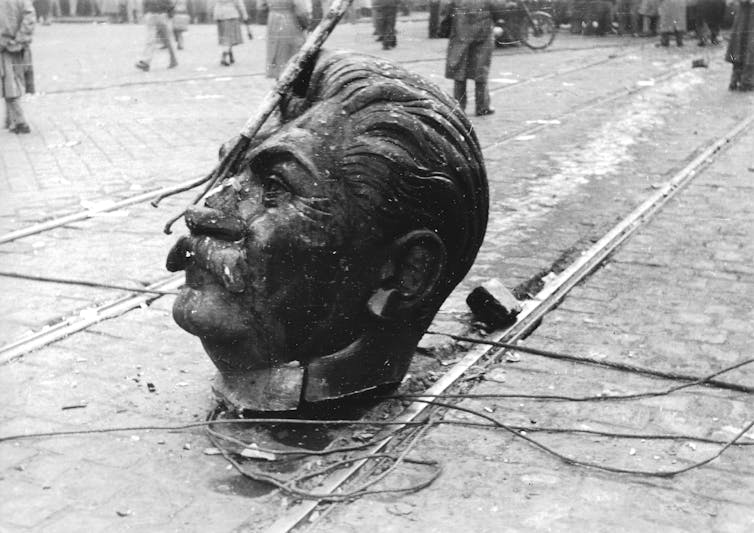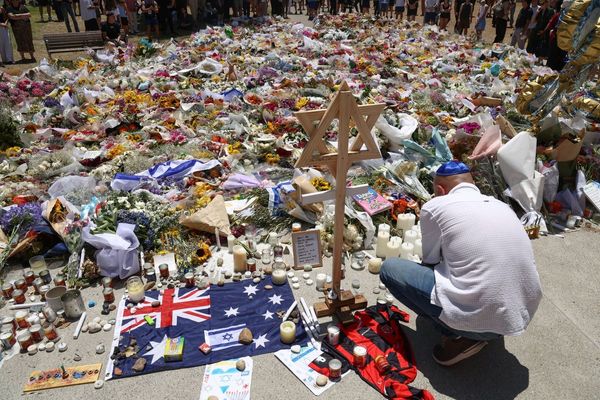A statue of Soviet dictator Joseph Stalin was unveiled in the Taganskaya metro station in Moscow in May, recreating a mural that was dismantled decades ago. It is the first such statue to be erected in central Moscow since Stalin’s death in 1953 and marks a disturbing new stage in Russia’s authoritarian path.
Tens of millions of people died as a direct result of Stalin’s policies between 1924 and his death. These policies included the forced collectivisation of agriculture, the Gulag labour camp system and the “great terror” – a wave of mass arrests between 1937 and 1938, including of key figures in the army.
Yet ultimate victory over Nazi Germany in 1945, with the support of Britain and the US, redeems Stalin in the eyes of Russia’s current rulers. For the Russian president, Vladimir Putin, this victory was one of the crowning achievements of the Soviet Union and remains a unifying force in modern Russia.
De-Stalinisation, which from 1956 to the late 1960s saw the dismantling of Stalin’s policies and legacy, meant no statues of him were erected from his death until the collapse of the Soviet Union in 1991. But 110 monuments have been built since then (at the last count in 2023), with 95 of them erected in the Putin era. The rate of construction multiplied after Russia’s 2014 annexation of Crimea.
Get your news from actual experts, straight to your inbox. Sign up to our daily newsletter to receive all The Conversation UK’s latest coverage of news and research, from politics and business to the arts and sciences.
These statues initially tended to be in peripheral parts of the Russian Federation, such as Yakutia, North Ossetia and Dagestan, and not in city centres. The renaming by presidential decree of the airport in Volgograd as Stalingrad in April 2025, to echo the city’s wartime name, was thus a significant moment.
But the statue in the Moscow metro, an architectural gem in the centre of Russia’s capital that is used by millions of people each day, is an even more important symbolic statement.
‘Stalinwashing’
Stalin’s reputation in Russia continues to recover. According to a poll from 2015, 45% of the Russian population thought the deaths caused by Stalin’s actions were justified (up from 25% in 2012). By 2023, 63% of Russians had an overall positive view of his leadership.
This reflects the view promoted in schools and amplified by the Russian media, where criticism of Stalin is rare. Even the 2017 British comedy, The Death of Stalin, was banned in Russia for fear of popping the bubble of public approval.
The purpose of rehabilitating Stalin is about boosting support for Putin’s regime, training Russians’ conformity reflex, and instilling pride in their history. But it also has external ramifications.
With the partial exception of Georgia, his birthplace, Stalin is widely reviled by Russia’s neighbours which were often the victims of Stalin’s repressive policies. This is especially true of Ukraine. A famine known to Ukrainians as the Holodomor was deliberately imposed there between 1932 and 1933 as part of collectivisation and killed as many as 3.8 million people.
As a result, his death unleashed de-Stalinisation accompanied by the destruction of his statues all over eastern Europe. This began during the 1956 Budapest uprising and was followed by later such reactions in Prague and elsewhere.

After the uprisings were put down, Stalin’s place was typically taken by the less controversial Vladimir Lenin, the revolutionary leader who founded the Soviet Union.
But since the 2014 Maidan revolution in Ukraine, which culminated in the ousting of pro-Russian president Viktor Yanukovych, Ukrainians have also been pulling down statues of Lenin. Other Soviet-era symbols have also been torn down in a wave of demonstrations known as Leninopad or Leninfall.
This is what has informed the latest intensification of Stalin-washing. The Ukrainian refutation of the symbolic heritage of the Soviet Union seems to have supercharged the Russian embrace of it, Stalin included.
Russia has restored statues of Lenin in the Ukrainian territories it occupies. And it has now also started erecting statues of Stalin, notably in the southeastern city of Melitopol, where a statue was unveiled in May to commemorate the 80th anniversary of the Soviet Union’s victory in the second world war.
This is against the law in Ukraine, where there is a ban on pro-Communist (and pro-totalitarian) symbolism. Russian forces have meanwhile been destroying memorials to the Holodomor in a battle over the meaning of the Soviet legacy.
Russia’s military strength
The re-elevation of Stalin promotes a narrow interpretation of his rule, stressing Russia’s military strength. Modern statues typically portray Stalin in a military uniform and evoke a sense of him as a victorious wartime leader.
In fact, some of the appeal of the symbol of Stalin lies in welfare provisions of his leadership where, despite imposing an often cruelly authoritarian system, education and healthcare were free for all. The same can be said for his use of fear as a work incentive. Russians sometimes still denounce complacent or inept officials with the imprecation: “If only Stalin was here to sort you out” (Stalina na vas net in Russian).
Nevertheless, it is the imperial version of Stalin that dominates, vindicating Russian refusal to reckon with its colonial past as the centre of the Soviet Union. Stalin’s record is sometimes defended within Russia on the basis that Winston Churchill, for instance, remains a British national hero despite a bloody past (such as his role in the Bengal famine of 1943).
While there is an element of truth in this, the difference is that Churchill’s shortcomings and complicity in the death toll attributable to the British empire are publicly discussed. Such criticism of Stalin is not permitted in Russia. Even the new statue in Moscow was erected under cover of the night, evading public scrutiny and debate.
The fact that the UK subjects its historical heroes to scrutiny is what distinguishes it from Russia, and defines it as democratic. At least for the time being.
Jeremy Hicks is a member of the UK Labour Party
This article was originally published on The Conversation. Read the original article.







